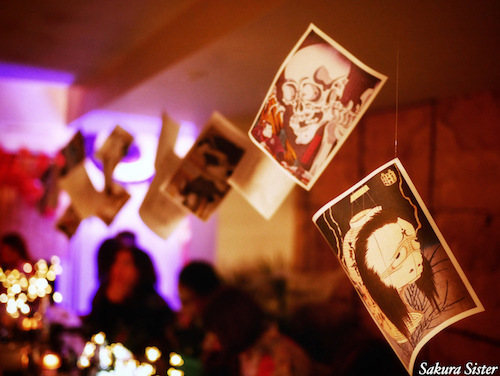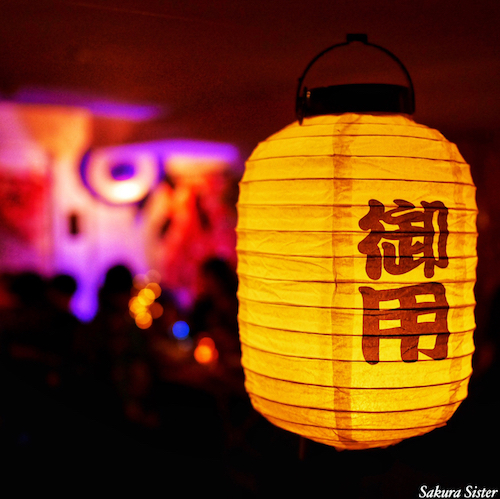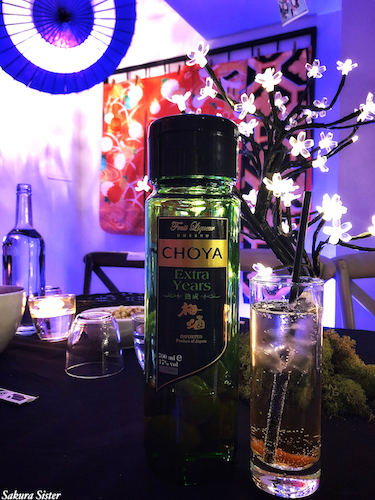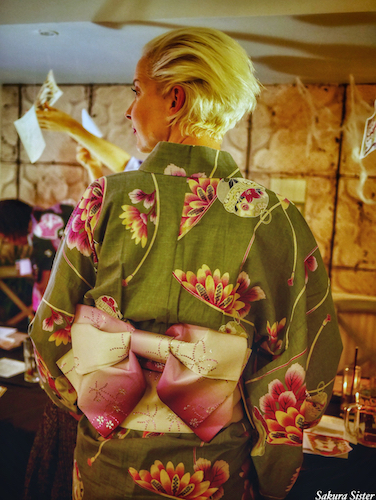Guest Writer / Natalie Leon – @Sakura_Sister_
In October I had the pleasure of attending Takayo Kimono Parties “Floating World” event.
Billed as an alternative way to spend Halloween. The concept was an immersive supper club experience that transports you back in time to Edo period Japan where you can indulge in some of the delicacies and sensual delights of the Floating World: most importantly via an introduction into the Japanese erotic art of Shunga.
So firstly, you may be wondering, what exactly is the Floating World?
It’s a place of wonder, wish fulfilment and escape, where people would go to watch plays and lose themselves in the theatre or to revel in the red light district. It was both a state of mind and a physical place. The most famous of which was The Yoshiwara in Edo, what we now call modern-day Tokyo. Edo was the capital of Japan, created by Tokugawa Ieyasu when he became shogun (military ruler of Japan). During the Edo period (1603-1868) and under the rule of the Tokugawa Shogunate Japan experienced peace and prosperity for 250 years, which lead to a flowering of the arts. Ukiyo-e (pictures of the Floating World) are one of the types of art that arose during this time.
The floating world and the art representing it was subversive; it challenged the authority of the world beyond its borders because once you stepped inside the Floating World, many of the restraints of society no longer applied. Through Ukiyo-e paintings and especially woodblock prints these hedonistic ideas were spread. The prints were cheap and fast to produce in large quantities, able to keep up with the pace of change as new kabuki actors and courtesans arrived and rose to fame. Anyone could afford to buy these prints, which depicted famous beauties, actors, flora and fauna and of course, erotica.
It was the illusive courtesans who became fashion trendsetters, like modern-day influencers, the most famous beauties often featured in ukiyo-e woodblock prints. Their eye-catching kimonos acted as advertisements, both for themselves and the clothing merchants who created them, to attract new clients. The procession of the oirans, the highest-ranking courtesans through the Yoshiwara was one of the districts greatest spectacles and an occasion for these women to wear their most sumptuous robes.
This is how our hosts, Takayo Kimono party gave us a taster of that rich and beautiful world here in London. Once we arrived at the restaurant and went down the stairs we left the real world behind. Entering into a room lit by paper lanterns hanging in the sky, and delicate glowing sakura trees on a long communal table, which created a warm, intimate feeling. The room was decorated with Japanese kimono, paper parasols and a brilliant collection of Edo period shunga prints, which were suspended above the table.
As the group assembled, we enjoyed aged Choya umeshu (plum wine) cocktails and were all gradually dressed in lightweight cotton kimono. The plum wine was sweet and syrupy, it tastes a little like almonds or marzipan, to cut the sweetness it was served on ice with soda water. I really enjoyed seeing everyone dressed in kimono, and since in the floating world people could dress as extravagantly as they wished, I thought it was a lovely touch. For most people, it was something they had never experienced before, so it broke down barriers and gave everyone something to talk about.
We sat down to a three-course dinner which was a Japanese inspired menu of items including a fusion version of one of my personal favourites, Nasu Dengaku, or miso glazed aubergine, this time served with tahini paste, which I thought worked well with the dish, an unusual but delicious pairing. After dinner, our host Takayo gave us each a booklet of shunga images, talking us through the stories behind them and as we examined the illustrations in our booklets, much laughter ensued. We used small electric torches to pick out the finer details in the images above our heads, and each chose our favourite piece. Finally, with the help of some tracing paper and calligraphy brush pens we created our own erotic masterpiece, which combined with the shunga booklet, was the perfect memento of the evening.
Shunga is Japanese erotic art, it literally means “picture of spring”. In Japanese, the word for spring is also a common euphemism for sex. They are sometimes also called pillow pictures or laughter pictures; some of them are genuinely amusing, as we found out! Shunga is hugely varied and depicts both heterosexual and LGBTQ+ lovers engaged in all sorts of explicit sexual encounters. Representations included both the young and old, people of all backgrounds and even demons and monsters; these creepier examples were especially apt for the Halloween event.
Despite it being unpopular with the Shogunate, who banned it in 1722, all classes of Edo society enjoyed shunga. So artists often hid their signatures in small details, such as calligraphy on a fan or used a pseudonym. There are many superstitions and urban myths around shunga, it was believed be a lucky charm against death if viewed by Samurai on the day of battle. It was also considered a talisman against fire, for the households and storehouses of merchant families. We also know that shunga was included in a brides dowry. Meaning that samurai, chōnin (wealthy merchants) and housewives all owned or had access to shunga. Importantly, all the artists known for their floating world woodblock prints also produced shunga, including Utamaro and Hokusai. It was Hokusai who created one of the most famous pieces of shunga, the instantly recognisable “Dream of a Fisherman’s Wife” c.1814, which I was amused to see hanging overhead at dinner, it infamously depicts a naked woman in the embrace of an octopus.






 Follow
Follow
